

Renewables Threaten German Economy & Energy Supply, McKinsey Warns In New Report. To stabilize the electricity grid and avoid becoming too dependent on imported natural gas, Germany is expanding coal mining to the Hambach forest, where environmental activists were arrested last September.
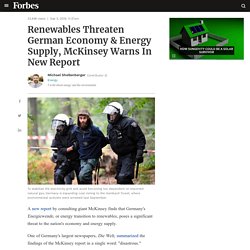
A new report by consulting giant McKinsey finds that Germany's Energiewende, or energy transition to renewables, poses a significant threat to the nation's economy and energy supply. One of Germany's largest newspapers, Die Welt, summarized the findings of the McKinsey report in a single word: "disastrous. " "Problems are manifesting in all three dimensions of the energy industry triangle: climate protection, the security of supply and economic efficiency," writes McKinsey. Energiewende-Index. Der Energiewende-Index betrachtet seit 2012 alle sechs Monate den Status der Energiewende in Deutschland entlang der drei Dimensionen des energiewirtschaftlichen Dreiecks: Klima- und Umweltschutz, Versorgungssicherheit und Wirtschaftlichkeit.
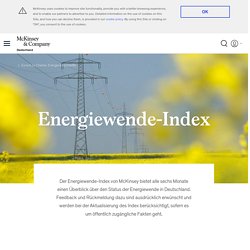
Innerhalb dieser Dimensionen werden insgesamt 14 Indikatoren analysiert und aktuell daraufhin bewertet, inwieweit sie ihre für 2020 geplanten Zielwerte im geplanten Zeitverlauf der Energiewende erreicht haben. Der aktuelle Index (Erscheinungstermin September 2019) liefert diesmal einen Gesamtüberblick über die Entwicklung aller Indikatoren seit Beginn der Untersuchung. Das Fazit: Deutschland verfehlt den Großteil seiner selbstgesteckten Ziele für die Energiewende bis 2020. Gleichzeitig ist mittelfristig nach dem beschlossenen Atom- und Kohleausstieg die Versorgungssicherheit gefährdet, wenn die abgeschalteten Kapazitäten nicht rechtzeitig flexibel ersetzt werden und der Ausbau der Transportnetze schneller vorankommt. Liebreich: We Need To Talk About Nuclear Power. Michael LiebreichSenior ContributorBloombergNEF We need to talk about nuclear.
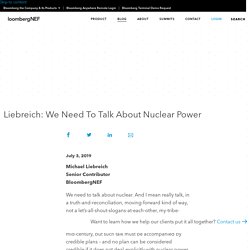
And I mean really talk, in a truth-and-reconciliation, moving-forward kind of way, not a let’s-all-shout-slogans-at-each-other, my-tribe-versus-your-tribe kind of way. Serious people are finally talking about decarbonizing national economies by mid-century, but such talk must be accompanied by credible plans – and no plan can be considered credible if it does not deal explicitly with nuclear power. If nuclear is in, what role will it play in the energy system? Germany to close all 84 of its coal-fired power plants, will rely primarily on renewable energy. Germany, one of the world’s biggest consumers of coal, will shut down all 84 of its coal-fired power plants over the next 19 years to meet its international commitments in the fight against climate change, a government commission said Saturday.

The announcement marked a significant shift for Europe’s largest country — a nation that had long been a leader on cutting CO2 emissions before turning into a laggard in recent years and badly missing its reduction targets. Coal plants account for 40% of Germany’s electricity, itself a reduction from recent years when coal dominated power production. 1:25 PM, Jan. 26, 2019 A previous version of this post said that Germany should have 30 coal-burning plants remaining by 2030. The correct number is eight. Kleinman Center for Energy Policy. Pricing carbon.
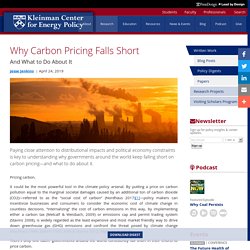
It could be the most powerful tool in the climate policy arsenal. By putting a price on carbon pollution equal to the marginal societal damages caused by an additional ton of carbon dioxide (CO2)—referred to as the “social cost of carbon” (Nordhaus 2017)[1]—policy makers can incentivize businesses and consumers to consider the economic cost of climate change in countless decisions. “Internalizing” the cost of carbon emissions in this way, by implementing either a carbon tax (Metcalf & Weisbach, 2009) or emissions cap and permit trading system (Stavins 2008), is widely regarded as the least expensive and most market friendly way to drive down greenhouse gas (GHG) emissions and confront the threat posed by climate change (Nordhaus 1994; Stavins 1997; Aldy & Stavins 2012; Stiglitz et al. 2018). There’s only one catch: governments around the world consistently fall short in their efforts to price carbon.
Winners and Losers: The Distributional Impacts of Climate Policy. Energy Institute Blog – Research that Informs Business and Public Policy. What you need to know about energy pricing as market complexities grow. Because energy consumption is one of the largest operating expenses for a data center or manufacturing operation, it’s important that owners and operators understand the potential for price volatility here in the United States.
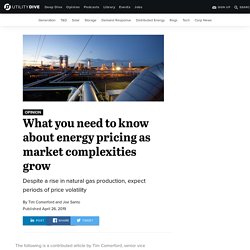
Natural gas and electric rates in the U.S. were stable for most of 2018, as higher demand for natural gas due to greater exports to Mexico and increased liquefied natural gas (LNG) shipments were offset by greater production of natural gas. As a result, supply and demand was kept in balance and prices remained in a tight band — that is, until November 2018, when prices spiked to a four-year high. Despite the relative stability of pricing last year, owners and operators of data centers and manufacturing operations should continue to be prepared for additional periods of volatility and price spikes — both in the natural gas and electricity markets.
This article explores why. Use it or lose it: The once-in-a-generation opportunity to change the US electric grid. Delegation Glidepath Memorandum. A grim look at the effort needed to hit the world’s big climate goal. Study: Adding power choices reduces cost and risk of carbon-free electricity. In major legislation passed at the end of August, California committed to creating a 100 percent carbon-free electricity grid — once again leading other nations, states, and cities in setting aggressive policies for slashing greenhouse gas emissions.

Now, a study by MIT researchers provides guidelines for cost-effective and reliable ways to build such a zero-carbon electricity system. The best way to tackle emissions from electricity, the study finds, is to use the most inclusive mix of low-carbon electricity sources. The $2.5 trillion reason we can’t rely on batteries to clean up the grid. A pair of 500-foot smokestacks rise from a natural-gas power plant on the harbor of Moss Landing, California, casting an industrial pall over the pretty seaside town.
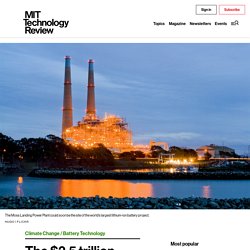
If state regulators sign off, however, it could be the site of the world’s largest lithium-ion battery project by late 2020, helping to balance fluctuating wind and solar energy on the California grid. The 300-megawatt facility is one of four giant lithium-ion storage projects that Pacific Gas and Electric, California’s largest utility, asked the California Public Utilities Commission to approve in late June. Collectively, they would add enough storage capacity to the grid to supply about 2,700 homes for a month (or to store about .0009 percent of the electricity the state uses each year). Why Renewables Can’t Save the Planet. When I was a boy, my parents would sometimes take my sister and me camping in the desert. A lot of people think deserts are empty, but my parents taught us to see the wildlife all around us, including hawks, eagles, and tortoises. After college, I moved to California to work on environmental campaigns. I helped save the state’s last ancient redwood forest and blocked a proposed radioactive waste repository set for the desert.
In 2002, shortly after I turned 30, I decided I wanted to dedicate myself to addressing climate change. I was worried that global warming would end up destroying many of the natural environments that people had worked so hard to protect. I thought the solutions were pretty straightforward: solar panels on every roof, electric cars in every driveway, etc.